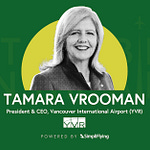In this episode of our ‘Sustainability in the Air’ podcast, Grace Cheung, General Manager of Sustainability at Cathay, speaks with SimpliFlying CEO Shashank Nigam and shares insights about industry collaboration and how merging marketing expertise with environmental leadership can help promote aviation sustainability.
With a unique journey from marketing to sustainability leadership, Cheung has been at the helm of Cathay’s environmental initiatives for the past seven years. She currently serves as Vice Chair of International Air Transport Association’s (IATA) Sustainability and Environmental Advisory Council and chairs the oneworld alliance Environment & Sustainability Board.
Here are the key highlights of the conversation:
Bridging the gap between technical experts and stakeholders (4:26)
Cathay’s approach to reaching 10% SAF by 2030 (19:09)
Local SAF production with EcoCeres and HSBC Hong Kong (22:26)
SAF cost considerations (30:09)
Cathay’s decarbonisation strategy, including fleet renewal (35:38)
The role of partnerships and collaboration in sustainability (40:02)
Cathay’s “Greener Together” approach (45:06)
Rapid Fire! (47:42)
Keep reading for a quick overview of the episode.
Why communication bridges matter in aviation sustainability
The adoption of sustainability initiatives hinges significantly on how they are communicated both within and outside an organisation.
However, the complexity of these initiatives can make communication difficult, even with technical experts’ passion and knowledge, hindering the message’s impact on the organisation and customers.
As Cheung recounts from her experience, “All my colleagues in the environmental affairs team are experts in the field – passionate and highly knowledgeable. However, they sometimes face challenges in effectively communicating the importance of these critical topics to the rest of the organisation and our customers.”
This communication gap can affect multiple levels of implementation:
At the board level, directors need to understand their personal liability and the strategic implications of environmental decisions.
Within operations, teams need clear guidance on how sustainability affects daily choices in areas ranging from fuel efficiency to waste management.
For customers, environmental initiatives must be communicated in terms that resonate with their travel preferences and values.
The ability to translate complex environmental initiatives into clear, actionable business language is crucial for gaining stakeholder buy-in and driving meaningful change. Drawing from her marketing background, Cheung has positioned herself as a bridge between technical experts and various stakeholders, helping to ensure that sustainability initiatives are both understood and implemented effectively across the organisation.
4 takeaways from the conversation
1. Evolution from compliance to strategic priority
Beginning with voluntary environmental reporting in 1996, Cathay was one of the first companies in Asia to publicly disclose its environmental impacts. Cheung says the company’s environmental journey reflects a three-tiered evolution in corporate sustainability thinking:
The first tier focuses on regulatory compliance, a fundamental “no-brainer” requirement for business operations, with businesses having no choice but to comply or cease operations due to regulatory mandates.
The second tier leverages clear commercial benefits, particularly evident in fuel efficiency initiatives. “Our biggest environmental footprint is carbon emission, and it’s directly related to how much jet fuel we use,” Cheung points out. With jet fuel accounting for approximately one-third of airline operating costs globally, carriers have strong financial incentives to reduce consumption, creating a natural alignment between environmental and economic objectives.
The third and most advanced tier moves beyond tangible commercial benefits to focus on long-term risk mitigation and brand value creation. This includes proactive measures to “do the right thing in advance” to mitigate the risk of reputational damage and prevent a loss of trust in the airline.
This evolution demonstrates how sustainability has transformed from a compliance requirement into a strategic imperative that protects and enhances business value while addressing environmental concerns.
2. Accelerating SAF development in Asia
Cathay’s commitment to achieving 10% SAF usage by 2030 represents a challenging yet strategic ambition. “It’s actually a very challenging goal for us to meet, especially considering we are based in Hong Kong. [..] There is no SAF usage mandate in our key markets in this part of the world in Asia,” notes Cheung.
The airline leverages its international network, particularly long-haul routes to Europe and North America, strategically sourcing SAF based on availability and commercial viability. “The 10% [SAF] doesn’t need to be evenly distributed across all routes, as the supply chain doesn't yet exist everywhere we fly,” Cheung explains.
Cathay has partnered with HSBC Hong Kong and EcoCeres to develop local SAF supply chains in Asia. Through the partnership, HSBC has committed to purchasing approximately 3,400 metric tonnes of SAF from EcoCeres for use by Cathay Pacific. Moreover, Cathay’s Corporate Sustainable Aviation Fuel Programme, launched in 2022, has attracted 15 corporate partners who, together in 2024, committed to using 2,650 tonnes of SAF.
“We’re seeing growing interest from corporations, both in terms of expanding their Scope 3 reductions and shifting from single-year commitments to multi-year commitments.”
With long-haul routes responsible for over 70% of international aviation emissions, SAF is the most practical solution for emissions reduction, as new technologies like hydrogen and electric aircraft won’t be viable for long-haul flights in the near future. While Cathay has committed HK$100 billion to fleet modernisation, including over 100 new fuel-efficient aircraft, SAF remains key to achieving its 2050 target, potentially reducing lifecycle carbon emissions by up to 80% compared to traditional jet fuel.
3. Understanding regional market dynamics
Cathay's research shows that sustainability initiatives, though not the primary factor in airline selection, can enhance brand affinity when combined with other service elements.
“The major brand drivers are still network, destinations, safety, comfort, and on-time performance,” says Cheung, noting that sustainability can positively influence customers when integrated with these core factors.
However, the impact of sustainability varies by customer segment, with younger passengers placing greater importance on environmental considerations compared to older generations, shares Cheung.
Geographic differences also play a role: European customers tend to have higher environmental awareness, while in markets like India and China, consumers are more concerned with immediate environmental issues, such as pollution and safety.
Understanding these regional and demographic variations can help airlines develop more effective sustainability strategies that align with local market expectations while contributing to global environmental goals.
4. Greener Together: collaborative efforts for sustainable aviation
Unlike traditional competitive sectors like marketing and route development, sustainability in aviation thrives on collaboration. As Cheung notes, “In marketing, you don’t talk to competitors. So, it’s quite refreshing in sustainability where there are so many challenges we need to tackle together as an industry.”
This collaborative spirit is critical given the urgency of the climate crisis. “We’re competing against time for sustainability,” says Cheung. “By sharing best practices, we can accelerate progress and create bigger impacts faster.” This also helps bring together industry expertise to address common challenges, like environmental policies and operational improvements.
Cathay embraces this ethos, reflected in their tagline, “greener together.” “We use ‘greener’ instead of ‘green’ because we know we’re far from being truly sustainable – whether it’s Cathay, aviation, or society as a whole… Every decision, big or small, can be a greener choice. While we still have a long way to go, each step brings us closer to a more sustainable future.”
This collaborative approach extends across the entire aviation ecosystem, ensuring that environmental initiatives are practical and effective by leveraging the collective expertise and resources of the industry. As Cheung notes,
“No single organisation can do it alone. you need to collaborate with different stakeholders, including policymakers, people across your supply chain, and customers.”
For February 2025, we’re pleased to feature 4AIR as our exclusive Sponsor of the Month. 4AIR is leading the way with the industry’s first framework to address aviation’s climate impact – offering clear, verifiable pathways to reduce and counteract emissions. Discover their services, including compliance monitoring and The Assure SAF Registry, to advance your sustainability efforts.












